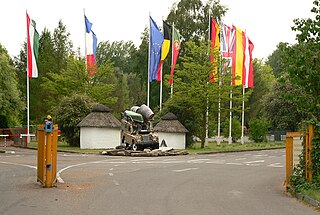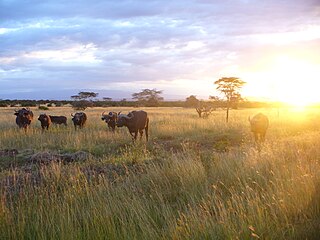
Wildebeest, also called gnu, are antelopes of the genus Connochaetes and native to Eastern and Southern Africa. They belong to the family Bovidae, which includes true antelopes, cattle, goats, sheep, and other even-toed horned ungulates. There are two species of wildebeest: the black wildebeest or white-tailed gnu, and the blue wildebeest or brindled gnu.

The term antelope is used to refer to a number of species of ruminant artiodactyls—i.e., multiple-stomached, cud-chewing, even-toed hoofed mammals—that are indigenous to most of Africa, India, the Middle East, Central Asia, and a small area of Eastern Europe.

The Bovidae comprise the biological family of cloven-hoofed, ruminant mammals that includes cattle, bison, buffalo, antelopes, and caprines. A member of this family is called a bovid. With 143 extant species and 300 known extinct species, the family Bovidae consists of 11 major subfamilies and thirteen major tribes. The family evolved 20 million years ago, in the early Miocene.

Oryx is a genus consisting of four large antelope species called oryxes. Their pelage is pale with contrasting dark markings in the face and on the legs, and their long horns are almost straight. The exception is the scimitar oryx, which lacks dark markings on the legs, only has faint dark markings on the head, has an ochre neck, and has horns that are clearly decurved.

The scimitar oryx, also known as the scimitar-horned oryx and the Sahara oryx, is an Oryx species that was once widespread across North Africa. In 2000, it was declared extinct in the wild on the IUCN Red List. This particular oryx is adapted to harsh desert conditions and can survive for months or even years without drinking water. A grazing animal, it derives most of its daily moisture intake from plants.

The rhim gazelle or rhim, also known as the slender-horned gazelle, African sand gazelle or Loder's gazelle, is a pale-coated gazelle with long slender horns and well adapted to desert life. It is considered an endangered species because fewer than 2500 are left in the wild. They are found in Algeria, Egypt, Tunisia and Libya, and possibly Chad, Mali, Niger, and Sudan.

Woburn Safari Park is a safari park located in Woburn, Bedfordshire, England. Visitors to the park can drive through exhibits, which contain species such as southern white rhino, elephants, tigers and black bears. It is part of the estates of the Duke of Bedford that also includes Woburn Abbey and its 3,000-acre (1,200 ha) deer park. The Safari Park itself covers 360 acres (150 ha).

The Serengeti-Park in Hodenhagen, Lower Saxony, is a zoo and leisure park in North Germany.

The Yotvata Hai-Bar Nature Reserve is a 3,000-acre (12 km2) breeding and reacclimation center administered by the Israel Nature Reserves & National Parks Authority, situated in the Southern Arava near Yotvata.

Animal migration is the relatively long-distance movement of individual animals, usually on a seasonal basis. It is the most common form of migration in ecology. It is found in all major animal groups, including birds, mammals, fish, reptiles, amphibians, insects, and crustaceans. The cause of migration may be local climate, local availability of food, the season of the year or for mating.
Mauritania's wildlife has two main influences as the country lies in two Biogeographic realms, the north sits in the Palearctic which extends south from the Sahara to roughly 19° North and the south in the Afrotropic realms. Additionally Mauritania is important for numerous birds which migrate from the Palearctic to winter there.

The wildlife of Kenya refers to its fauna. The diversity of Kenya's wildlife has garnered international fame, especially for its populations of large mammals. Mammal species include lion, cheetah hippopotamus, African buffalo, wildebeest (Connochaetes), African bush elephant, zebra (Equus), giraffe (Giraffa), and rhinoceros. Kenya has a very diverse population of birds, including flamingo and common ostrich.

Natural Bridge Wildlife Ranch is a ranch and wildlife refuge in Texas. The ranch is a Texas Land Heritage Property, certified by the State of Texas for being used for agriculture by the same family for over 100 years. It comprises over 400 acres of Texas Hill Country publicly accessible by automobile.

The Tibesti-Jebel Uweinat montane xeric woodlands is a deserts and xeric shrublands ecoregion in the eastern Sahara. The woodlands ecoregion occupies two separate highland regions, covering portions of northern Chad, southwestern Egypt, southern Libya, and northwestern Sudan.
The High Delta Drive Thru Safari Park was a 40-acre (16 ha) safari park located in Delhi in Richland Parish in northeastern Louisiana. The park was about midway between Vicksburg, Mississippi, and Monroe, Louisiana, located off Louisiana Highway 17 9 miles (14 km) north of the Interstate 20 Exit 153. The animal park featured exotic and endangered species.

Fossil Rim Wildlife Center is a 501(c)(3) non-profit conservation center near Glen Rose, Texas. They specialize in the breeding of endangered species, public education, scientific research and natural land management. The facility has over 1,000 animals from 50 species. Guests have access to guided and self-guided tours across the center's 1800 acres of Texas Hill Country, as well as lodging, dining and educational facilities.

A gazelle is one of many antelope species in the genus Gazella. This article also deals with the seven species included in two further genera, Eudorcas and Nanger, which were formerly considered subgenera of Gazella. A third former subgenus, Procapra, includes three living species of Asian gazelles.

Al Areen Wildlife Park is a nature reserve and zoo, located in Sakhir, Bahrain. It is one of five other protected areas in the country and it is the only designated protected area on land, in the country.
Buffelspruit Nature Reserve is a smallish nature reserve in the far north of the Eastern Cape, South Africa.

The spotted hyena is the most carnivorous member of the Hyaenidae. Unlike its brown and striped cousins, the spotted hyena is primarily a predator rather than a scavenger. One of the earliest studies to demonstrate its hunting abilities was done by Hans Kruuk, a Dutch wildlife ecologist who showed through a 7-year study of hyena populations in Ngorongoro and Serengeti National Park during the 1960s that spotted hyenas hunt as much as lions, and with later studies this has been shown to be the average in all areas of Africa. However spotted hyenas remain mislabeled as scavengers, often even by ecologists and wildlife documentary channels.
















